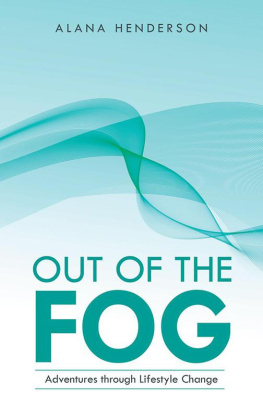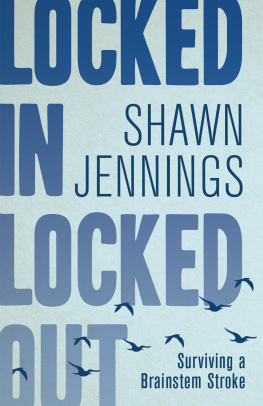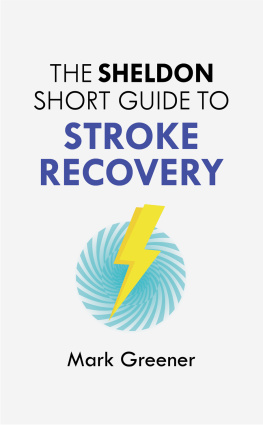OUT OF THE FOG
Adventures through Lifestyle Change
ALANA HENDERSON

Copyright 2016 Alana Henderson.
Fun Run photograph courtesy of Marathon-Events: www.marathon-photos.com
Author and pole photographs courtesy of Heath Wade Photography: www.heathwade.com
All rights reserved. No part of this book may be used or reproduced by any means, graphic, electronic, or mechanical, including photocopying, recording, taping or by any information storage retrieval system without the written permission of the author except in the case of brief quotations embodied in critical articles and reviews.
Balboa Press
A Division of Hay House
1663 Liberty Drive
Bloomington, IN 47403
www.balboapress.com .au
1 (877) 407-4847
Because of the dynamic nature of the Internet, any web addresses or links contained in this book may have changed since publication and may no longer be valid. The views expressed in this work are solely those of the author and do not necessarily reflect the views of the publisher, and the publisher hereby disclaims any responsibility for them.
The author of this book does not dispense medical advice or prescribe the use of any technique as a form of treatment for physical, emotional, or medical problems without the advice of a physician, either directly or indirectly. The intent of the author is only to offer information of a general nature to help you in your quest for emotional and physical well-being. In the event you use any of the information in this book for yourself, which is your constitutional right, the author and the publisher assume no responsibility for your actions.
Any people depicted in stock imagery provided by Thinkstock are models, and such images are being used for illustrative purposes only.
Certain stock imagery Thinkstock.
ISBN: 978-1-5043-0209-8 (sc)
ISBN: 978-1-5043-0210-4 (e)
Balboa Press rev. date: 05/18/2016
Contents
In memory of Barb
Introduction
Journey Out of the Fog
From my earliest recollection of learning to read, the fascination of words and the beauty of language has been my passion. Throughout my school education, I developed and refined my skills in many language-related areas. I excelled in literacy-based subjects and languages, becoming an avid reader, public speaker, leader and debater. I enthusiastically engaged in musical theatre and drama, entered writing competitions, and compiled diaries, letters and short stories.
During my work life it was a natural step into a career that drew on and exploited my language skills. This began with adult teaching and expanded to establishing a successful business in career consultation, interview coaching, editing and writing a wide range of business and other documents. This included publishing in a popular small business magazine.
To lose these lifelong, cherished skills to a strokein just a few minuteswas devastating: personally and professionally. To know how to regain them was far beyond my comprehension. Shortly after, complicated by obesity and concurrent diagnoses of breast cancer and diabetes, I launched headlong into an intensive project of self-managed recovery. With the insidious nature of all three illnesses, and the enormity of the task, there were no guarantees.
Out of the Fog begins with the lead up to and the occurrence of the stroke, followed by fear and frustration in the immediate aftermath in hospital-based acute stroke services. The subsequent chapters, in a loose chronology, describe an enlightening and sometimes emotional journey of self-help. Surprisingly, along the way I discovered many simple, affordable and unconventional resources around me that I could use as tools in this project.
I realised that my recovery and survival involved a complete lifestyle change. The shock of what that really meantmuch more than a throwaway linewas the catalyst. As my project accelerated, I began to question societys expectations of older people and the implications for my survival, if I followed the well-worn path into aging.
I learned about my resilience, the necessity of creative thinking, and the value of unconditional support of friends. I also learned how to resist negativism from others thatintentionally or notaccompanies such a massive change and can affect well-established relationships and routines.
The pathways explored in Out of the Fog were sometimes planned, and on other occasions appeared from nowhere. They were challenging, frustrating, exhilarating and motivating. They arose largely from intensive self-education, questioning conventional practices, and taking the plunge in unchartered waters.
Out of the Fog puts the consumer in the drivers seat to avoid falling into stereotypical images and behaviours imposed by one-size-fits-all services in a world of convenience, shortcuts and commercially-driven standards. These may not be in everyones best interest and may even be detrimental to recovery from major illness.
Through a practical approach, Out of the Fog raises many questions and provides some solutions for retaining the critical skills that underpin the right to choice, independence, and dignity, through ones life journey.
Come with me on a journey of challenge and adven ture.
Alana Henderson
Chapter One
A Very Public Stroke
4.30am: I woke suddenly to the alarm on a day that had begun like many others in the past year. I had worked long into the night, followed by a few hours of restless sleep. I was booked at a clients premises for a full day, working with a recruitment panel. I made some strong coffee, feeling cheated that I had to leave my warm bed for the coldness of my office. With a home-based business, I was quickly working again on a clients unfinished editing job from the previous night, before leaving for the day.
5.40am: I felt tired and agitated, but the warm shower was comforting. Turning my focus to the busy day ahead, I left at 6.00am, grabbing a slice of toast to eat on the way, to begin work by 7.00am. I knew that the highway would be very busy at that time of the morning.
6.40am: Caught in slow-moving traffic, I started to worry that I might be late. I felt irritable and impatient to get out of the long line of cars to reach my destination. Arriving with only a few minutes to spare, I spent the following nine hours in the interview room, with only a brief break for lunch. I used that time to return a few calls to clients. I struggled in the afternoon to think, feeling tired and needing some substantial food and relaxation. But I knew it was unrealistic on that day.
4.00pm: As I prepared to pack up my materials, I felt fatiguedeven exhaustedand very hot. I splashed some cool water on my face at the amenities before setting off for home. It briefly occurred to me that as it was winter, I might be coming down with flu. I reminded myself that I didnt have time to be sick. I had to see two clients and complete jobs in my business that night for the looming end-of-financial year. I also had to play piano for a choir rehearsal for two hours. I knew I had to work late or overnight again to complete some urgent jobs before attending another interview panel the next day.
4.45pm: I arrived home and had a quick coffee before I greeted a client for a 5.00pm appointment, and then another at 6.00pm. By this stage I was very tired, irritable, hungry for a decent meal, and anxious about meeting some tight deadlines. I also needed to be at rehearsal within the next hour.
6.45pm: I replied to some emails, made some priority calls, and looked over the list of jobs on my list for that night after rehearsal.
7.20pm: As I ran to the car knowing that I would be late, I drove quickly for the 15-minute trip. My face felt hot and I felt stressed. As I drove, my thoughts were rushing over many things. I told myself several times that I had an impossible night ahead. I became frustrated with the traffic, which was travelling too slowly and the red lights were taking a long time to change. I could feel myself becoming more pressured as I wound through the suburban streets to the practice venue.
Next page





